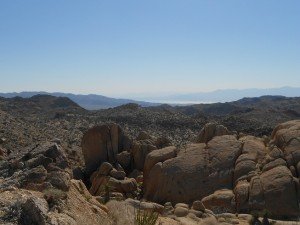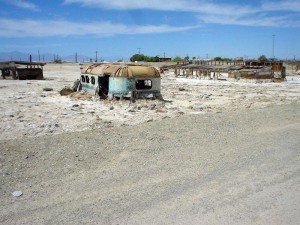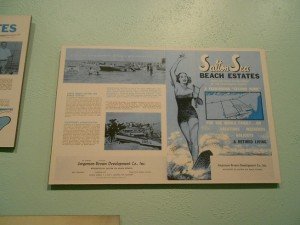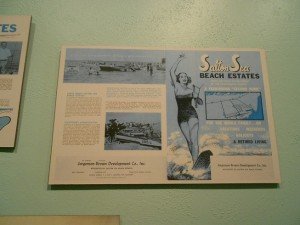Thank you for reading this post, don't forget to subscribe!

If you’ve ever flown into either Los Angeles or San Diego from the east, chances are you’ve noticed a very large body of water in the middle of the desert. A very large lake seemingly out of nowhere. What you’re looking at is the Salton Sea in the Sonoran Desert. What’s even more surprising about this massive body of water is that prior to the first decade of the twentieth century the Salton Sea didn’t exist.
The Salton Sea, one of the world’s largest inland body of water, is located east of the Palm Springs California area. The Salton Sea is also located at one of the earth’s lowest spots at 227 feet below sea level.
How the Salton Sea Came About
Before the Salton Sea California formed the area was referred to as the Salton Sink. The very reason why the sea formed and stayed was nothing less than a man made engineering debacle.

There is nothing more important to a desert area than water. Where’s there’s water there’s people. Without it there is no way for settlements and agriculture to survive. Many historians and archeologists will point to the absence of water as to the primary reason why many of the ancient North American Native tribes abandoned areas and resettled elsewhere.
When the 1900’s began southern California was growing rapidly. Los Angeles, in particular, and in large part due to the railroad, was growing at a very fast pace. The obvious source of fresh water for increased agriculture was the Colorado River. The plan was to divert water from the Colorado River into the Salton Sink for the purpose of agriculture. After canals were constructed the Salton Sink, for a time, became fertile. In fact, the Southern Pacific Railroad had a railroad siding settlement in the Salton Sink.
The Debacle
A few years into the project, the Imperial Canal which was built from the Colorado River to the Salton Sink became filled with river silt. As a result, new canals and levees were built on the river north of the clogged canal.

While you would assume that this measure would alleviate the problem, the year 1905 brought very heavy snows to the Rockies in addition to more than normal rainfall. The result was that the Colorado River roared down and breached levees along the new canals. Instead of diverting some of the Colorado River flow to the Salton Sink, for a few years until 1907, the entire Colorado River flowed on and off into the sink. The Southern Pacific Railroad settlement as well as others were submerged under the new sea. For it’s part the Southern Pacific Railroad hauled in rail car loads of dirt to try to stem the flooding at the head gates on the Colorado River.
Because the entire area of the Salton Sink was filled with salt deposits it didn’t take long for the fresh river water to turn into salt water. The river fish that flowed into the Salton Sink along with the fresh water eventually died off. The salinity of the water was deemed saltier than even ocean water. Over the years the 500 square mile Salton Sea (depending on rainfall the sea increases and decreases in size) became increasingly polluted with runoff water container fertilizers.

In actuality, over hundreds and thousands of years, the Colorado River did at various times overflow into the Salton Sink and then eventually would evaporate. The Salton Sea this time hung around. This was due to the runoff of the salty, fertilizer and pesticide laden irrigation water from valley farms. The entire ecology of the area changed and unfortunately not for the better.
Efforts to Promote the New Inland Sea
Interestingly enough, eventually real estate promoters and some recreational enthusiasts touted the Salton Sea as being a southern California recreation playground. Indeed, at one time the real estate business along the Salton Sea boomed. Salton City on the seas west shore was the most populous settlement.
Fishing in the Salton Sea was quite popular in the 1950s. The average depth of the body of water is about thirty feet. The Salton Sea was stocked with various species of salt water ocean fish. Unfortunately, in regards to Salton Sea fishing, the only fish of any real quantity that appears to have adapted to the extremely salty inland sea is the tilapia which was imported from Africa. Tilapia fishing is quite active today. Gone are the yacht clubs and the plans for massive recreational development. The primary reason for the decline was the sea itself. Because of the chemical pollution and the ever increasing salinity, the smell above the water can be unpleasant. The smell of decayed algae blooms each spring and early summer keep many away. In addition, the smell of dead fish seems to be a year round problem.

Birding at one time was quite healthy. However since the mid 1990’s more and more birds have died off. It has been said that at one time more than 600 dead birds per day were collected. The exact reason for the die off of birds has not been determined. Avian botulism was initially considered the reason but there is some disagreement on this. Still today, birdwatching does go on at the Salton Sea.
Desert Development
What eventually happened to the hoped for shangra-la of the southern California Sonoran Desert can be experienced today. All you need to do is visit Palm Springs, Rancho Mirage and Indian Wells in the Coachella Valley and that’s where the real recreational and resort development took place.
When you see today’s lavish golf courses and resorts along the entire line of towns in the Palm Springs area, remember that this area was nothing but arid desert scrub land when the Salton Sea occurred by accident in 1905. Big resort development occurred in the desert, it just occurred about sixty miles west of the Salton Sea.
Links to two additional articles on our Western Trips site you’ll find interesting is a Visit to Joshua Tree National Park and the famous Scotty’s Castlein Death Valley California.

Visiting the Salton Sea Area
The Salton Sea is bordered on the south by the fertile Imperial Valley. West of the Salton Sea is the Anzo-Borrego Desert State Park. The Sonny Bono Salton Sea National Wildlife Refuge as well as the Salton Sea State Recreation Area are on it’s shores. The Salton Sea State Recreation Area offers more than a thousand campsites, picnic sites, trails and a Visitor Center. This recreation area runs from the town of North Shore to Bombay Beach.
While there have been several efforts to address the ecological problems of the Salton Sea, and efforts continue to this day, the area does receive an estimated 100,000 plus visitors each year. The recreational activities include boating, water skiing, sailboarding, hiking and fishing (mostly tilapia) and birdwatching.
To reach the Salton Sea State Recreational area from the city of Palm Springs, drive eastbound for about 18 miles on Interstate 10 and exit to the right at the Brawley / El Centro 865 Expy. After 12 miles turn left at CA 195/66th Ave and continue on CA 195 for just under a mile. Turn right on CA 111 and drive about 21.5 miles.
